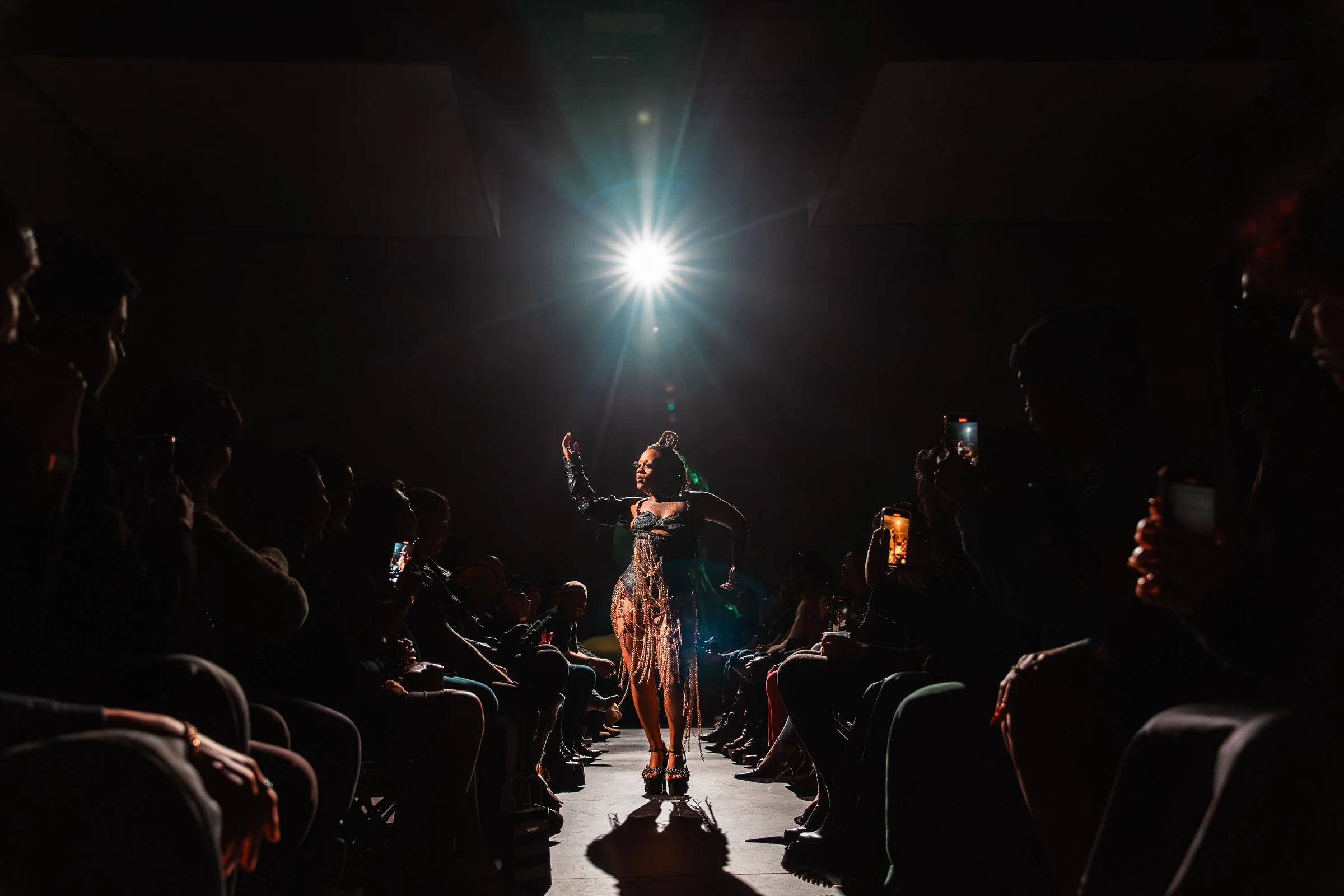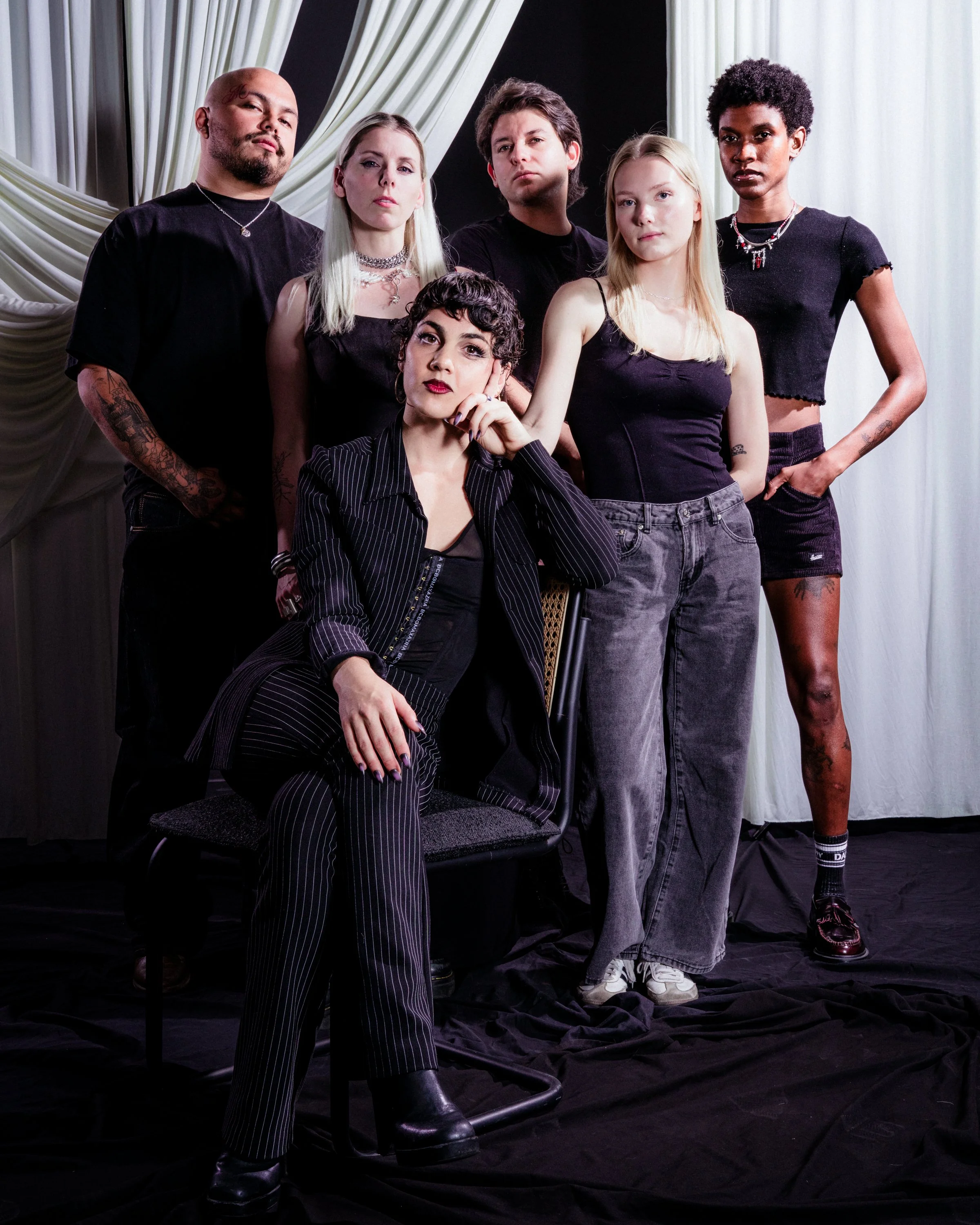Bloodbath Studio
Interviewed by Olivia Emigh
Austin’s Bloodbath Studio is transforming fashion into collective storytelling. Known for its immersive runway shows and cinematic fashion films, the collective has built a reputation for uplifting queer, trans, and BIPOC artists — not only through representation, but by structuring itself so every collaborator has true ownership. Their projects (Desert Roses at Willie Nelson’s Ranch, Veneration, and the themed Metanoia show with a pop-up VIP art gallery) have blended fashion, film, performance art, and community in a way that’s distinctly Texan and fiercely collaborative. Ahead of their New York Fashion Week film screening with Glaze Zine at TV Eye on September 16, we spoke with the core team about how they work, what they’ve built, and where they’re headed.
Cinema, Couture, Community
The Bloodbath Studio collective — front: Hannah Varnell; back (from left): Benjamin Medina, Danielle Shepherd, Navarr Gonzales, Maia Vallibhuvet, and Alexandra Sleeping. Photo: Christopher Davila (@christopherdavila).
Can you take us back to the beginning of Bloodbath Studio? How did it all start?
Hannah Varnell: Our first independent show was Veneration, but before that we produced Desert Roses at Willie Nelson’s Ranch during Lucktoberfest. I had pitched a fashion show as a way to bring in queer artist communities that hadn’t had prior access to that space. I invited designers I’d met through film projects, a production designer to build a runway, and Third and Lamar productions to livestream it, and we created something extremely beautiful in an iconic Texas venue.
Navarr Gonzales: The real turning point came at a party months later, watching footage from Desert Roses. Ben, Hannah, Dashe and I stepped outside and decided we didn’t want to wait for someone else’s platform. We’d start our own, grassroots, and keep building on what we’d started.
Benjamin Medina: We’re all puzzle pieces. Everyone brings their own vibe, and when they come together, they make a whole new world.
How do you make decisions and share leadership among so many different creatives?
Hannah Varnell: It’s less about directives and more about finding momentum then connecting the right people so ideas can take form.
Danielle Shepherd: We allocate responsibility based on resources and skills. Whoever has the capacity or expertise takes the lead.
Benjamin Medina: If it’s your idea, then you do it, and you get creative ownership over it.
Alexandra Sleeping: We meet, share ideas, and figure out who has the time and energy to execute them.
Navarr Gonzales: There’s a lot of trust. If someone is extremely passionate about an idea, we have full faith in them to lead it.
Christiana Rodriguez: Our diversity is an asset, not a barrier. Each creative brings a unique perspective. Leadership and decision-making emerge naturally from those perspectives, with individuals taking the lead in their areas of expertise while collaborating wherever our ideas intersect.
If you catch a big, complex idea and form an almost obsession around it, magic comes through. People feel the passion behind it and want to be involved.
— Hannah Varnell
How do you make sure collaborators have real agency in the process?
Maia Vollbrecht: From day one, I was asked, “What do you want to do? What would make you happy?” That inspired me to take ownership, like curating the VIP lounge at Metanoia into a pop-up gallery.
Danielle Shepherd: We give collaborators a say in everything, from marketing direction to set design to styling. We don’t bring people in as “beginners” and treat them like beginners; we assume they can do something until they tell us otherwise.
Benjamin Medina: Everyone wants to build something they can take credit for. That’s what keeps people engaged, knowing their fingerprints are on the final piece.
Hannah Varnell: I try to identify pieces of a project that can be fully handed over to someone. When they own it, it becomes more meaningful, and the whole show benefits.

Photo by Brittany NO FOMO - Gothess Jasmine wearing Alive by Benjamin at the 2023 VENERATION showcase
Your work uplifts queer, trans, and BIPOC artists. How does that mission translate into tangible opportunities?
Christiana Rodriguez: Within an industry often barriered by elitist structures, these shows provide artists with high-quality, portfolio-building content that is often out of reach. This access is career changing.
Navarr Gonzales: We intentionally cast models who might not usually get the opportunity, representing all body types and abilities.
Alexandra Sleeping: Models often tell us they’re grateful for the safe space to try, even fail, and still be celebrated.
What kinds of projects have you produced, and how have they evolved?
Hannah Varnell: Desert Roses brought fashion to Willie Nelson’s Ranch. Veneration was our first fully independent show. Metanoia blended fashion, film, and a curated VIP art gallery. Every December show feels ceremonial, a way to close the year and reflect.
Navarr Gonzales: Themes start from a word or emotion, and designers build collections specifically for it. That’s why our shows feel cohesive, everyone’s creating with the same emotional starting point.

Photo by Naught at the VENERATION film shoot - stylist Dev England and model Alexandra Sleeping
What advice would you give to others looking to start something like Bloodbath Studio?
Hannah Varnell: Keep it simple and focus on what you can realistically do with the skills and resources you have. That's advice I keep telling myself too but honestly, if you catch a big, complex idea and form an almost obsession around it, magic comes through. People feel the passion behind it and want to be involved. So, you have to find a balance between simplicity and dreaming bigger than you can see currently. Burnout is real, so be gentle with yourself. Make space to hear your own voice or whoever is trying to speak through you.
Navarr Gonzales: Put yourself out there. Go to events, start conversations, and don’t be afraid to ask for help.
Alexandra Sleeping: Be a little delusional. If you have a creative vision, show up for it. Collaboration happens naturally when you put yourself in the room.
What’s next for Bloodbath Studio?
Hannah Varnell: Bloodbath is ever-evolving and we like to say it is never in its final form. We’re looking to keep exploring the right brand partnerships – brands that value artistic independence – to allow the work we are doing to not only provide platforms but also other forms of compensation, like financial and resources. We’d also love to produce more film projects, like a mini-series highlighting our designers.
Navarr Gonzales: Texas will always be our home base, we want people to know they don’t have to go to New York or LA to find powerhouse talent– it’s here.
Celebrate one of Texas’s most visionary collectives as they bring their singular mix of cinema and couture to New York. Catch Bloodbath Studio’s film screenings and Q&A at the Glaze Zine NYFW Afterparty on September 16 at TV Eye in Ridgewood, NY. Follow @bloodbath.studio for updates and join in supporting a collective that is as democratic and collaborative as it is visionary.
